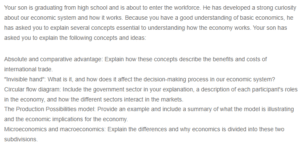Economic Concepts
Absolute and Comparative Advantage
Absolute advantage arises when one firm or country can manufacture at a faster and higher rate for more profit than a competing firm or country. In contrast, comparative advantage occurs when a firm or country can manufacture at a lower cost than other countries and firms. The absolute advantage concept describes the benefits and costs of international trade by considering labour costs, available capital, and access to natural resources on manufacturing costs. Comparative advantage describes the benefits and costs of international trade by considering the opportunity cost of manufacturing goods and its impact on the product price.
“Invisible Hand”
The invisible hand is an economic concept that posits people make decisions based on their benefits and self-interests (Blaug, 2018). The idea affects the decision-making process in the financial system by creating predictable economic systems such as supply and demand. Therefore, firms can predict the demand and supply of products and make necessary adjustments to prevent shortages and surpluses.
Are you interested in obtaining a unique copy of ” Economic Concepts” ? Contact us.
Circular Flow Diagram
The circular flow diagram demonstrates how the economy operates based on how services, goods, and money are moved in the economy. The main sectors in the chart are the business, household, foreign trade, and government sectors. The sectors interact through trade. The household sector consumes commodities, and the business sector produces the required commodities. The government sector puts money into the economy by spending government funds on programs such as the Social Security program. The foreign trade sector injects cash into the economy through imports and exports.
The Production Possibilities Model
The Production Possibilities model posits that the production of one product or service may only increase if there is a decrease in the production of another product or service. The model determines whether a country’s economy has reached maximum efficiency. For example, a government may experience a situation where some services are underutilized while others are over-utilized. For instance, healthcare services may be over-utilized, whereas tourist services may be underutilized. In such a case, the government will increase the production of high-quality healthcare services and reduce the production of tourist services.
Microeconomics and Macroeconomics
Microeconomics includes studying how businesses and people decide on price and resource allocation based on regulations, taxes, and government control. Conversely, macroeconomics includes studying a country’s economic behaviour and how its policies affect the economy. According to Rodrigo (2020), economics is divided into these two subdivisions because of the need to explain the broad and smaller picture based on the elements in the economics sector.
References
Blaug, M. (2018). Invisible hand. The New Palgrave Dictionary of Economics, 6977–6980. https://doi.org/10.1057/978-1-349-95189-5_1217
Rodrigo, C. (2020). Micro and Macro: The Economic Divide. Finance & Development | F&D. Retrieved September 26, 2022, from https://www.imf.org/external/pubs/ft/fandd/basics/bigsmall.htm
ORDER A PLAGIARISM-FREE PAPER HERE
We’ll write everything from scratch
Question
Your son is graduating from high school and is about to enter the workforce. He has developed a strong curiosity about our economic system and how it works. Because you understand basic economics well, he has asked you to explain several concepts essential to understanding how the economy works. Your son has asked you to explain the following concepts and ideas:

Economic Concepts
Absolute and comparative advantage: Explain how these concepts describe the benefits and costs of international trade.
“Invisible hand”: What is it, and how does it affect the decision-making process in our economic system?
Circular flow diagram: Include the government sector in your explanation, a description of each participant’s roles in the economy, and how the different sectors interact in the markets.
The Production Possibilities model: Provide an example and include a summary of what the model is illustrating and the economic implications for the economy.
Microeconomics and macroeconomics: Explain the differences and why economics is divided into these two subdivisions.

